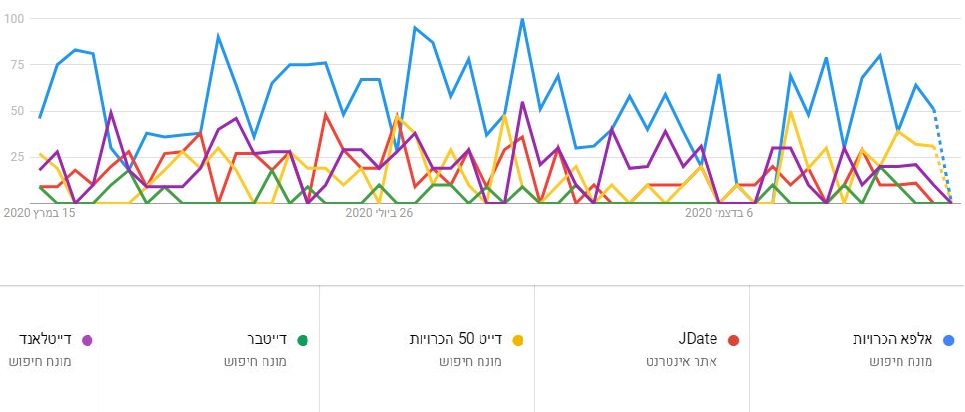עם עלייה של טכנולוגיות התקשורת והאינטרנט, התעתדות לחתונה לא תכוף נגמרה. עם הכניסה לעולם הזה של מערכות הכרויות ואתרי הכרויות לחתונה, החיפוש אחר בן זוג או בת זוג עבור החתונה נפץ את השמיים. אולם, עם כמות רבה של אתרי הכרויות לחתונה לבחור מביניהם, זה עשוי להיות מעט בלבולי. במאמר זה, אנו נספק לך טופס לאתרי הכרויות לחתונה הטובים ביותר בשוק ונסיים עם טיפים חשובים לחיפוש אחר מילת המפתח "אתרי הכרויות לחתונה". 1. WeddingWire WeddingWire הוא אתר הכרויות לחתונה מוביל שמציע כלי חזק לחיפוש אחר בן זוג או בת זוג. האתר מאפשר לזוגות ליצור פרופיל משותף ולחפש אחר זוגות פוטנציאליים לחתונה. בנוסף, האתר מציע מגוון רחב של מומחי חתונות וספקי שירותים עבור החתונה. 2. The Knot The Knot הוא אתר הכרויות לחתונה עם מערכת מקיפה וטובה לחיפוש אחר בן זוג או בת זוג. האתר מציע גם מגוון רחב של כלי חיפוש וסינון כדי לסייע לזוגות למצוא את הזוג המתאים להם. בנוסף לכך, האתר מציע כלי לתכנון חתונה מקיף ומכיל באופן קבוע מידע עדכני על חדשות ומגמות חתונה. 3. Brides.com Brides.com הוא אתר הכרויות לחתונה מוביל ומציע כלי חזק לחיפוש אחר בן זוג או בת זוג. האתר מאפשר לזוגות ליצור פרופיל משותף ולחפש אחר זוגות פוטנציאליים לחתונה. בנוסף לכך, האתר מציע מגוון רחב של מאמרים וטיפים לחתונה בנושאים שונים, כמו גם מידע על מומחי חתונות וספקי שירותים עבור החתונה. 4. Zola Zola הוא אתר הכרויות לחתונה חדש ומתפתח שמציע כלי חזק לחיפוש אחר בן זוג או בת זוג. האתר מאפשר לזוגות ליצור פרופיל משותף ולחפש אחר זוגות פוטנציאליים לחתונה, וגם מציע מגוון רחב של מומחי חתונות וספקי שירותים עבור החתונה. בנוסף, האתר מציע כלי לתכנון חתונה מקיף ומכיל סקירות על מומחי חתונות וספקי שירותים, כמו גם מידע על טרנדים חדשים ומגמות בתחום החתונות. כפי שאנו יודעים, חיפוש אחר מילת המפתח "אתרי הכרויות לחתונה" משתמש באלגוריתמי חיפוש מתקדמים כדי להביא למשתמש את התוצאות הטובות ביותר. כדי לאפטימזציה לחיפוש, יש לקחת בחשבון את הכלים הבאים: 1. בחר במילת מפתח ברורה ומדוייקת כדי למנוע רעש בתוצאות החיפוש, כדאי לחפש אחר מילת מפתח ברורה ומדוייקת, כגון "אתרי הכרויות לחתונות בישראל" או "אתרי הכרויות לנשים ל
נפגשים הכרויות בחינם. הכרויות בחינם וללא דמי מנוי המוביל בישראל ! אנו מאמינים שבשביל לצאת לדייט כדי למצוא אהבה וקשר רציני לא צריך לשלם אתרי הכרויות לחתונה. בניגוד לאתרי הכרויות מסחריים - פה הכל בחינם ולא משלמים כדי להכיר. ברגע שנרשמים, ניתן לבצע את כל הפעולות באתר בצורה חופשית וללא כל הגבלות !!! רוצים לפגוש ולהכיר אותם ? נופר גרושה (2+) בת 32 מאור יהודה ישראל. אתר הכרויות חינם - לאבלי אתרי הכרויות לחתונה. לאבלי הכרויות הינו אתר הכרויות וותיק ואיכותי. בלאבלי הכרויות תוכלו למצוא אהבה מתוך מאגר ענק של אנשים המחפשים הכרויות לקשר רציני, הכרויות לחתונה והכרויות כלליות. אתר הכרויות עם הרשמה חינם אתרי הכרויות לחתונה. הכרויות לחתונה - אתרים ואפליקציות מומלצות [2023]. במאמר זה נעבור על כמה טיפים לשימוש באתרי היכרויות לחתונה. בין אם אתם חדשים הטיפים האלה יעזרו לכם להגדיל את הסיכויים שלכם למצוא את בן/ת הזוג. Jsmart - אתר ההיכרויות של ישראל I ההרשמה בחינם אתרי הכרויות לחתונה. Jsmart - אתר ההיכרויות של ישראל I ההרשמה בחינם בואו למצוא אהבה וזוגיות רצינית באתר ההיכרויות שכובש את ישראל! לייקים ללא הגבלה, פילטר חיפוש חכם, והכי חשוב- שליחת הודעות ישירה למי שרוצים להכיר. הירשמו עכשיו You need to enable JavaScript to run this app.. חתונה - אתר הכרויות חינם - לאבלי - Lovely. אתר הכרויות Lovely הינו אתר ההכרויות המוביל והאיכותי בישראל. באתר הכרויות לאבלי תוכלו להכיר לקשר רציני ולמצוא אהבה ומערכת יחסים, הכל תלוי באיזה סוג היכרות הינכם מעוניינים.. לאבלס - הכרויות למטרת נישואין | חתונה. אתרי הכרויות מומלצים למטרת זוגיות וחתונה עם סיכויי ההצלחה הגבוהים ביותר


מה זה בחורה איכותית
. יוצאים לדייט ראשון? - כדאי שתקראו את זה…. הכרויות XYDate - אתר הכרויות איכותי לכל מטרה - גברים בלבד - דף מספר pageNum. ברוכים הבאים לאתר הכרויות XYDate - אתר הכרויות איכותי ומוביל בישראל לכל מטרה: הכרויות לזוגיות, הכרויות לסקס, אהבה, חברות או ידידות אתרי הכרויות לחתונה. הגיע הזמן למצוא סוף סוף בן/בת זוג איכותי לכל מטרה - בין אם זה .
חילופי זוגות הארץ
. יואנה ותומר: למצוא אהבה מעבר למשיכה מיידית. כשאנחנו מפנים את תשומת הלב שלנו ליואנה ותומר, אנחנו מוצאים את עצמנו נזכרים במשתתפים קודמים מעונות קודמות, נועם קציר ורוני לוי. יואנה, בלונדינית . אתרי הכרויות לחתונה. תיעוד: הגיעו לחתונה חמושים וירו באוויר
מין בקר גייל
. מורידים סרטים? דפדפן כרום עלול לחשוף אתכם לסכנות - וואלה! טכנולוגיה אתרי הכרויות לחתונה. פטריק שלאפפר (Patrick Schläpfe), אנליסט תוכנות זדוניות בצוות המחקר של HP Wolf Security: "כדי להגן מפני האיומים האחרונים, אנו ממליצים למשתמשים ולארגונים להימנע מהורדת חומרים מאתרים לא מהימנים, בדגש על אתרים פיראטיים. אתרי הכרויות לחתונה. מת מפצעיו עבריין מוכר שנדקר במהלך חתונה ליד אשקלון. האזינו לכתבה. עבריין מוכר בשנות ה-30 לחייו, שנדקר בלילה האחרון בחניה של גן האירועים "גני צבי" ליד אשקלון, מת מפצעיו הערב (רביעי) בבית החולים ברזילי. המשטרה מסרה כי היא חוקרת חשד לרצח. עד כה לא .. רצח העבריין מחוץ לחתונה ליד אשקלון: 4 חשודים נוספים נעצרו. המשטרה עצרה ארבעה חשודים נוספים במעורבות ברצח העבריין בן דוידוביץ, שנדקר מחוץ לחתונת חברו ליד אשקלון אתרי הכרויות לחתונה. ארבעת החשודים, תושבי אשקלון, יובאו היום לבית משפט השלום בעיר לדיון הארכת מעצרם. בית .. נפגשים הכרויות בחינם. נפגשים - אתר שבא מאהבהבחורות אתיופיות ערומות
. הכרויות בחינם וללא דמי מנוי המוביל בישראל ! אנו מאמינים שבשביל לצאת לדייט כדי למצוא אהבה וקשר רציני לא צריך לשלם אתרי הכרויות לחתונה. בניגוד לאתרי הכרויות מסחריים - פה הכל בחינם ולא משלמים כדי להכיר. ברגע שנרשמים, ניתן לבצע את כל הפעולות באתר בצורה חופשית וללא כל הגבלות !!! רוצים לפגוש ולהכיר אותם ? איוש רווקה בת 32 מבת ים ישראל קריסטל גרייס אתרי הכרויות לחתונה. שליש גן עדן - הכרויות לדתיים ב-App Store. מחפשים היכרויות לקשר רציני? לחתונה? שליש גן עדן הוא יישומון ההיכרויות המוביל והאיכותי בישראל, הכרויות לדתיים ומסורתיים, אתר ההיכרויות שמחתן הכי הרבה יהודים בישראל - בהתחייבות! למעלה מ200 אלף הורדות, ואלפי זוגות שכבר . אתרי הכרויות לחתונה. רשימת אתרי הכרויות מומלצים 2023 - ️ - הכרויות ופנאי לפנויים ופנויות. אתר הכרויות הגדול בישראל עם מאות אלפי פנויים פנויות מכל הארץ המחפשים קשר רציני וזוגיות. אתר הכרויות מומלץ, איכותי ומתקדם. אז אם אתם רוצים למצוא את החצי השני אתרי הכרויות לחתונה. הצטרפו עכשיו לאתר דייטלנד, ואולי כבר הערב תצאו לדייט… קרא עוד להצטרפות חינם דייט 50 פלוס. החצי השני - אתר הכרויות לקשר רציני בלבד אתרי הכרויות לחתונה. ONLYU - אתר הכרויות השייך לארגון החצי השני הינו אתר הכרויות לאקדמאים בעלי השכלה גבוהה והכרויות פרק ב המחפשים קשר רציני. החצי השני דואג לחיבור בין אנשים כבר למעלה מ 28 שנים כאשר החיפוש באתר נעשה בהתאמה דו כיוונית ומאפשר לחוות את ההנאה בחיפוש האהבה הדרך לקשר זוגי מתחילה באתר החצי השני הורידו את אפליקציית החצי השני. מחפשת זוגיות - מחפשת קשר רציני- אתר הכרויות חינם - פופנאי. אתרים מומלצים להכרויות: דייטלנד - אתר ההכרויות הגדול והמוצלח בישראל. באתר מאגר ענק של פנויים ופנויות מכל הארץ המחפשים אהבה, זוגיות וקשר רציני. מטרת האתר דייטלנד היא לספק שירות הכרויות רציני .. הכרויות פיליפיניות - אתר הכרויות חינם לחלוטין - פופנאי. באילו אתרי הכרויות מומלץ לחפש אחר הכרויות פיליפיניות. בעיקר במקרים בהם ברצונך לחפש אחר בת זוג ספציפית לחוויה יחידה או קשר מכל סוג, מומלץ להיעזר באתר הכרויות ייעודי אשר מציע קטגוריה התואמת .. 5 סיבות להירשם באתר הכרויות לחרדים + המשכיות לחתונה!. צפיות בכתבה 3,957 5 סיבות להירשם באתר הכרויות לחרדים + המשכיות לחתונה! תוכן עניינים נושא השידוך הוא אחד הנושאים החשובים יותר בעולם החרדיאתר הכרויות טינדר
. צעירים וצעירות מחפשים את החצי השני שלהם כדי להקים בית ומשפחה. לעתים מדובר בשידוכים בין משפחות או חברים קרובים, אך לפעמים יש צורך לחפש את החצי השני במקום אחר. ואכן, עולם האינטרנט פותח את שעריו גם בפני החרדים.סקס חינם גמירות
. אתר הכרויות חרדי - חתונה בת קיימא: הכרויות, חתונה, זוגיות. אתר הכרויות חרדי הינו פתרון מצוין לגרושים וגרושות הרוצים לפתוח פרק ב בחייהם אתרי הכרויות לחתונה. גרושים ללא ילדים יכולים למצוא רווקים בגיל מתבגר שמעוניינים להתחתן אתרי הכרויות לחתונה. אתר הכרויות חרדי הוא פתרון מעולה גם לאקדמיים דתיים הרוצים אקדמיים כמותם. הם יוכלו לעשות זאת בצורה נוחה באמצעות אתר הכרויות.. צאט היכרות: תוצאות מנוע חיפוש עם דירוג גולשים. חיפשת: צאט היכרות טוטאל צאט totalchat.co.il צאט הכרויות www.popnai.co.il וואלה,צאט נענע הכרויות - סרציק www.searchiik.co.il Waplog - צאט הכרויות פגוש למצוא חברים waplog.com להכיר אנשים חדשים ב-Badoo, להתחבר, לדבר בצאט, לפלרטט badoo.com צאט | צאט | צט | צט | היכרויות בצאט - XOOX www.xoox.co.il. 3 אתרי היכרויות לגיל השלישי - זוגיות ונישואין אתרי הכרויות לחתונה. אין תגובות צפיות בכתבה 3,945 3 אתרי היכרויות לגיל השלישי תוכן עניינים בני הגיל השלישי מבינים היום שהעולם השתנה, התפתח טכנולוגית וכי עליהם לפעול בהתאם. בני ה-60 ומעלה גולשים באתרי היכרויות באינטרנט ומחוברים לרשתות החברתיות לפחות כמו הצעירים.. דייטלנד - סקירת אתרי הכרויות - הכרויות ופנאי לפנויים פנויות. דייטלנד ( DATELAND) הינו אתר הכרויות מתקדם ואיכותי המיועד לפנויים ופנויות בכל הגילאים ומכל רחבי הארץ. באתר דייטלאנד תוכלו להנות מפלטפורמת הכרויות פשוטה, מאובטחת ונוחה שתאפשר לכם לחפש בן זוג או בת זוג מתוך מאגר עצום של רווקים ורווקות וכן גרושים גרושות, אלמנים ואלמנות שמעוניינים לפתוח פרק ב בזוגיות.. הרשמה חינם לאתר הכרויות לדתיים - הכרויות לדתיים | מסורתיים | חרדים .. הירשמו חינם ותמצאו את שאהבה נפשכם! אני גבר אני אישה כבר נרשמת בעבר לאתר? לחצ/י כאן מי אנחנו? אתר היכרויות "שניים שהם אחד" הינו אתר ההכרויות המוביל והאיכותי לציבור הדתי.. שידוכים אתרי הכרויות - חתונה בת קיימא: הכרויות, חתונה, זוגיות אתרי הכרויות לחתונה. בשנים האחרונות אתרי שידוכים אתרי הכרויות הולכים ותופסים פופולאריות בכל המגזרים. אתרי שידוכים אתרי הכרויות טובים לצורך יצירת קשר ראשוני עם בן הזוג השני, ובדיקה האם יש התאמה בסיסית, ותחומי עניין משותפים. קשר של פנים אל פנים בין בחור לבחורה, שונה מקשר וירטואלי אתרי הכרויות לחתונה. בחיי נישואין מתגלים תכונות האופי של בני הזוג, ואז נבדקת ההתאמה האמתית בין בני הזוג.. הכרויות | שידוכים | הכרויות רווקים ורווקות - אתר הכרויות חינם - לאבלי. לאבלי הכרויות הינו אתר הכרויות וותיק ואיכותי. בלאבלי הכרויות תוכלו למצוא אהבה מתוך מאגר ענק של אנשים המחפשים הכרויות לקשר רציני, הכרויות לחתונה והכרויות כלליות אתרי הכרויות לחתונה. אתר הכרויות עם הרשמה חינם. הצטרפו עכשיו | דייט פארטי - DateParty. אתר הכרויות - דף הבית שלכם למגוון הכרויות ברשת: אתר הכרויות למטרות אהבה, אתר הכרויות למטרת סטוצים, אתר הכרויות ומטרות רומטיות ועוד.בחורות צעירות בסקס
. אתר היכרויות דייט 4 יו מרכז אלפי גולשים אתרי הכרויות לחתונה. הצטרפו לאתר עוד היום.. הכרויות | הכרויות נשים וגברים בנס ציונה | הכרויות פנויים פנויות בנס .. לאבלי הכרויות הינו אתר הכרויות וותיק ואיכותי. בלאבלי הכרויות תוכלו למצוא אהבה מתוך מאגר ענק של אנשים המחפשים הכרויות לקשר רציני, הכרויות לחתונה והכרויות כלליות. אתר הכרויות עם הרשמה חינםסקס ישראלי אמת או חובה
. הכרויות לגיל השלישי - אתר הכרויות החצי השני אתרי הכרויות לחתונה. הכרויות לגיל השלישי אתרי הכרויות לחתונה. הגיל השלישי יכול להיות שלב מאתגר בחיים, הן מבחינה פיזית והן מבחינה נפשית. במיוחד לא קל להעביר את שנות הפנסיה והזקנה לבד, ללא בן או בת זוג אתרי הכרויות לחתונה
מין קוץ ישעיה ז
. אולי בגלל זה קשה היה לגולשים לקרוא על אורחי חתונה שנסעו ברכבת פרטית מתחנת סבידור בתל אביב עד לכפר ויתקין אתרי הכרויות לחתונה. מדובר בשירות ותיק שעלה .. תקן אבטחת מידע - משרד החינוך. גרסה 2.5 - 4.12.2016. לתקן אבטחת המידע המלא - כולל פירוט הסעיפים שעודכנו מגרסאות קודמות אתרי הכרויות לחתונה. בשאלות הקשורות לתקן אבטחת מידע אפשר לפנות אל גב שני נחום, רכזת צוות בדיקות טכנולוגיות, טל: 03-7407215 או בדוא"ל:pniot .. "חתונה מהאגדות" הסתיימה באסון: 10 אורחים נהרגו בתאונה באוסטרליהתחתוני מין
. כ-40 מוזמנים לחתונה ביקב בניו סאות וויילס חזרו בסיומה למקום הלינה שלהם באוטובוס, שככל הנראה שהתהפך. 11 נפצעו, הנהג שרד - ונעצר. במשטרה ציינו כי הנסיעה הייתה בתנאי ערפל: "יום של שמחה נגמר באובדן הרסני" אתרי הכרויות לחתונה. משאית גוררת מכונית בכביש אחרי שפגעה בה. איך להימנע - וואלה! רכב. ככה לא תגיעו למצב הזה אתרי הכרויות לחתונה. ברחבי הווטסאפ רץ הסרטון שצולם בצפון הארץ בו נראית משאית שגוררת את מכונית פרטית אחרי שפגעה בה לאורך עשרות מטרים לפני שנעצרת בצד. למה זה קורה ואיך אפשר להימנע מזה אתרי הכרויות לחתונה. למי זה .. חתונה ממבט ראשון או האח הגדול: מי מגנטה את הצופים למסך? | מעריב. חדשות רעות ל"רשת": הפרק המיוחד של ריאליטי הדגל של הערוץ לא הצליח לטפס לראש טבלת הרייטינג, וזכה ל-8.7% בלבד, לעומת חתונה ממבט ראשון שגרפה 13.1%. "הפטריוטים" בערוץ 14 נושפת בעורפה של רשת עם 7.6%. "שב"כ צריך להיכנס לאירוע": ראש עיירית לוד מתייחס להודנא הדרמטית בעיר. כל צד מתחייב לשמור על שקט מלא ולקחת אחריות מלאה על אנשיו. אם תהיה בעיה, יש לפנות מייד לראש העיר, כדי לפתור את הבעיה". רביבו טען היום (ראשון) בגלי צה"ל: "שב"כ צריך להיכנס לטיפול באלימות ולפגוע קצת .. אגד חוזרת להפעיל את קווי אשכול עוטף ירושלים מערב - וואלה! רכב. אגד חוזרת להפעיל את קווי האוטובוס באשכול עוטף ירושלים מערב. לראשונה מאז נרכשה בידי קרן קיסטון זכתה החברה במכרז להפעלת אשכול קווים חדש, באמצעות חברת בת חדשה, ובתנאים שונים משל אגד הוותיקה ..jai rencontre le diable streaming vostfr
escort 24 horas
tenue sexie pour femme ronde
natalya krasavina nude
remy la croix nude
sex oferty leszno
30000 sek to pln
club libertin ales
bruna biancardi nude
escorte girls montauban